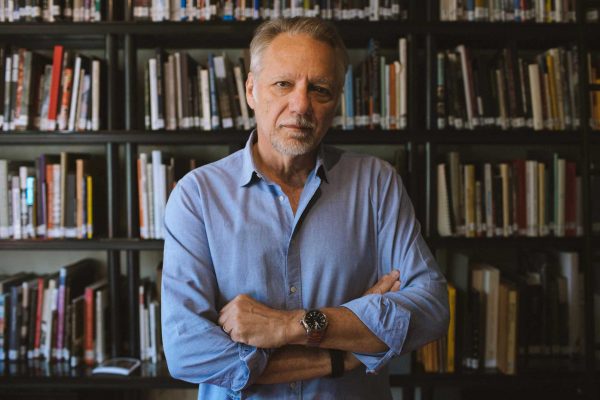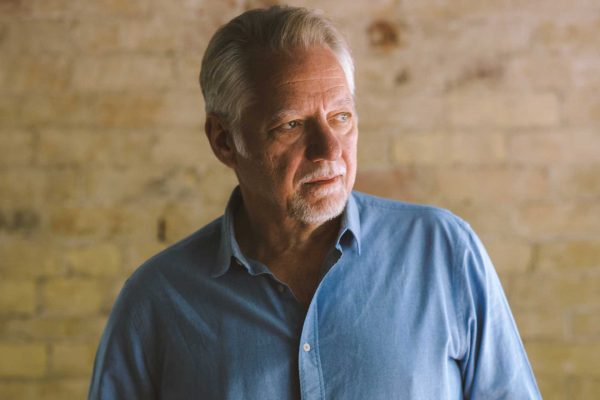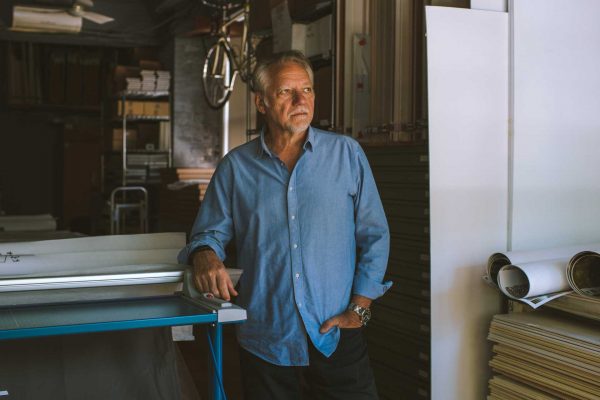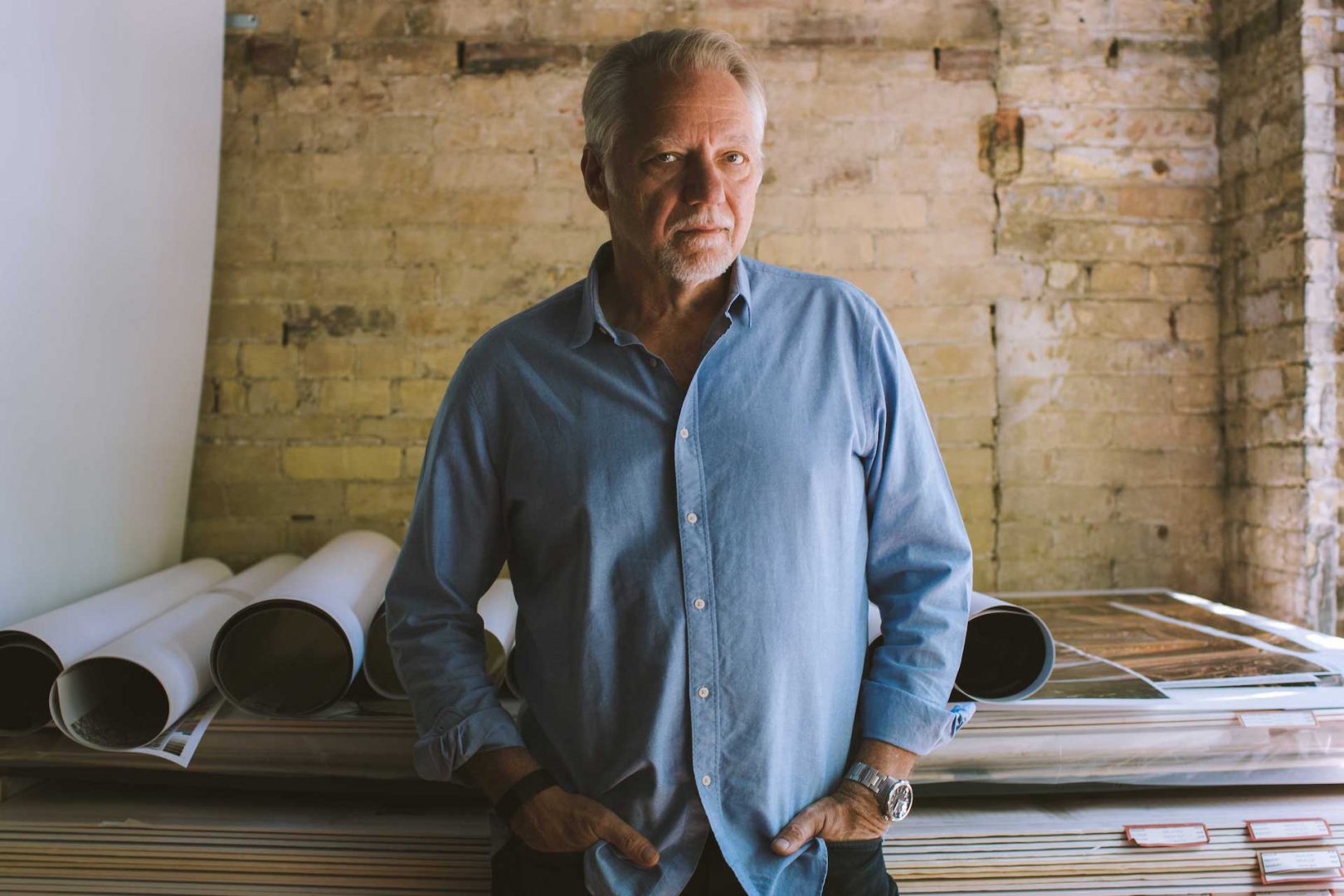By Meghan Yuri Young Photography by Max Power Internationally renowned Edward Burtynsky has devoted his career to documenting how our insatiable desire for consumption impacts our environment. Burtynsky's most ambitious project took him into uncharted…
By NowPlayingToronto
By Meghan Yuri Young
Photography by Max Power
Lush green forests razed into bleak landscapes by deforestation. Ever-growing mountains of plastic and trash. Ships carrying multiple storeys of shipping containers filled with goods for our consumption and eventual disposal. Such bleak, concerning visuals replaced gadget and clothing ads on the screens enveloping Yonge-Dundas Square when Edward Burtynsky debuted what he called his most ambitious projects during the 2022 Luminato Festival. A multidimensional walkthrough experience, In the Wake of Progress, featured 40 years of the renowned visual artist’s documentation of human impact on the planet.
While Burtynsky’s work is steadfast in its exploration of our consumption’s consequences, how he delivers his sublime imagery has never been fixed. And, even after decades of work, he isn’t afraid to try something new.

Meghan Yuri Young: For those who are, somehow, not familiar with your impact, can you tell us a little about who you are and what you do?
Edward Burtynsky: I’m a practicing visual artist working in photography and also other mediums. I work in the film format, augmented reality, and large high-resolution murals. I’ve been working with themes and imagery all aimed at a singular idea: how we, as humans, have been shaping the planet to our needs and desires. Specifically, the consequence of human expansion on the planet.
My work began by showing that, and now, I think it’s moved more clearly into a concerned artist looking at a big planetary problem that continues to unfold. I’ve become a chronicler of some of the largest human interventions into nature that exist on the planet — whether it’s the biggest dam in the world, large-scale cities, oil fields, or deforestation. I’ve done the research and gone places that show the scale of resource extraction and human expansion on the planet.
MYY: The fact that you’re able to marry that colossal undertaking of capturing the horrific things we’re doing to the planet with beauty it’s powerful. Your work has been described as “sublime horror.” How does it feel knowing your images will resonate differently for each individual who sets eyes on them?
EB: Part of what I’ve always wanted to do is engage as an artist. I want to engage with the audience. I want to make work that people are challenged or taken by when standing in front of it. The main thing I work towards is the viewer standing in front of the piece itself. The book, or poster, or online experience of it are all secondary, surrogate experiences to the actual thing that I worked towards: the print on the wall.
 Everything else is a derivative of that, albeit sometimes very interesting and powerful. I like the book format because it contains all the thoughts and ideas behind the whole body of work. It gives it context versus just being an individual image floating in the world. I think it’s important that people continue to grapple with these issues. The images and films allow a departure point for conversations, whether it’s at home with families and kids or whether it’s at schools and people in their business. It helps jump-start the conversation, so people realize that we need to move to action.
Everything else is a derivative of that, albeit sometimes very interesting and powerful. I like the book format because it contains all the thoughts and ideas behind the whole body of work. It gives it context versus just being an individual image floating in the world. I think it’s important that people continue to grapple with these issues. The images and films allow a departure point for conversations, whether it’s at home with families and kids or whether it’s at schools and people in their business. It helps jump-start the conversation, so people realize that we need to move to action.
Artists having this kind of material allows for an inflection point. It is like the necessary evidence we could point to and say, “Look. This isn’t a graph on a piece of paper or an article in a science magazine.” People see it and think, “This is actually something that I can understand, comprehend, and then realize.” So, I think visual artists have a very powerful role in the telling of that story and the importance of the crisis we actually are in.
MYY: Your work has been in national and international galleries and spaces but when it came to the 2022 Luminato Festival, it was on an especially massive scale. Tell me about that.
EB: It’s actually kind of crazy. That one big screen, we called it The Book, on the Eaton Centre itself, I think it’s almost 100 ft. high, maybe 65 ft. wide. According to folks at Luminato, from what they’ve researched, I don’t think anybody’s ever done a whole takeover of every digital screen in the main square of the city.
When you drill down to the complexity of making this experience, it’s quite something. I have to applaud Luminato for their persistence of not only convincing eight different companies to give us the screens for free but also that we had to put servers into each one of their central distribution points, where they distribute the ads onto those screens. That way, we could intervene and sync it all up with our own central computer at the Square to be able to control the visuals for colour balance and whatever else. That’s not a small feat. That’s a lot of negotiated space.
[In the Wake of Progress is] an all-Canadian production. Phil Strong composed the sound. iskwē is doing the vocals. Bob Ezrin is my co-producer. [It was exciting] to launch it as a public event and create this moment in the Square where I [hope that those who experienced it did] a double take of what this piece is about … It was a public piece to engage not only the people who came to Luminato to see it but also those who happened to be walking through that Square. I love the fact that somebody could just have been coming back from buying something at Nordstroms, and all of a sudden, they were in the middle of this thing with a shopping bag in their hand going, “Hmm.”
MYY: At the time, Luminato artistic director, Naomi Campbell, said one of the festival themes was climate change and the environment. How does that feel, having advocated and created art about our impact on the planet for decades?
EB: Well, truthfully, a little frustrating. I don’t think the crisis is being addressed on a scale that it needs to be addressed. It’s in our value of media and bombardment, whether it’s social media, advertising, or the latest shooting in America. There’s this constant parade of distractions — many that are not to be trifled with. There are terrible things that are happening, but at the base of all of that is the fact that I don’t think at any other time in human history could we all sit around and say we may be the architects of the demise of the planet. That’s not a small thing. That can keep you up at night.
From my point of view, I’m speaking more urgently because the time for discussion and considering the problem is over. It’s time for action because action is what we need.
MYY: I feel like we’re always told to do this or that and then, inevitably, end up finger pointed at big corporations. Is there a way to feel in control over the impact we have on the planet?
EB: In my own personal life, I’m doing what I can. And where I cannot avoid, I try to, at least, offset. I’ve had an electric car for five years now, and I just put in a solar system up in the country so I can now recharge with my own solar system. I’m getting off the grid now and changing all the things that I can change; my diet and all those other things. We can all do a lot. Not to say a person can be completely absent of issues, but we’ve realized we’re part of the problem and we’re implicated in this problem. So, if we can do something, we should.
MYY: I think this is a good place to let that sink in. Your relationship to Earth is obviously strong. What about your relationship with Toronto, specifically?
 EB: Well, it’s interesting. I was born in St. Catharines. So, on a clear day, when I would sit on the shores of Lake Ontario, I could see the CN Tower across the lake. I remember when I first started coming to Toronto as a young kid. I probably went when I was like 13, and then I came when I was around 17 with a bunch of my friends … I remember walking and trying to get my head around the city. It was always so big and I would think, “How could I ever figure out how to live and work and make it a city that I can belong to? It just seems so impersonal.”
EB: Well, it’s interesting. I was born in St. Catharines. So, on a clear day, when I would sit on the shores of Lake Ontario, I could see the CN Tower across the lake. I remember when I first started coming to Toronto as a young kid. I probably went when I was like 13, and then I came when I was around 17 with a bunch of my friends … I remember walking and trying to get my head around the city. It was always so big and I would think, “How could I ever figure out how to live and work and make it a city that I can belong to? It just seems so impersonal.”
I never thought of moving to Toronto. It was actually the prompting of a teacher at Niagara College, who was not even part of the regular teaching faculty. He was a night school teacher and a professional photographer. He was a really neat guy and gave me assignments. I would always come back with something above and beyond what everybody else had done. I was really interested in communicating with pictures, taking his assignments and converting them into an image. He came to me and said, “You know, you have a natural aptitude. You should go to Ryerson.” At that time, it was the best photography school in the country. And I went, “Oh, okay. If I can be an artist, and make a living taking pictures, that would be my dream come true.”
So, that’s when I came to Toronto, applied to Ryerson, and got in. I was 21 when I came. It was a four-year bachelor’s program, and it’s there that I really had my eyes opened to the history of photography, art, music, psychology, and sociology. I absorbed it all, especially how to think and how to build ideas around photography.
It was actually, for me, a perfect education. It really taught me to have a respect for the technical aspects of the medium. I ended up taking that craft of making images and started Toronto Image Works, in 1985, to be able to print my own prints and to open up the ability for other artists and photographers to have control over their own work.
MYY: I love that so much, that you created something to help your fellow artists. I feel like that speaks to how important community and helping others is to you.
EB: I’ve always been part of city-building. And that’s what I’ve always loved about Toronto. I was at the very beginning of CONTACT Photography Festival, the inception of the Scotiabank Photography Award. I was also very instrumental, with several others, to bring Scotiabank to the whole idea of supporting photography as a cultural property. City-building has always been something that gives me pleasure simply by giving back.
People always ask me, “Why don’t you move to a studio in New York or Berlin?” And I say, “Because Toronto’s been great to me.” I have a studio here, a practice, and I have great people that I work with. It’s a very, very livable city, you know? So, I’ve always argued that Toronto’s a perfect place to do what I do. And I can go anywhere in the world I want from here.
MYY: I also identify with finding pleasure in giving back. I want to know, what’s your guilty pleasure as an activist and advocate?
EB: My guilty pleasure is travel. I love going out into the world. It helps me understand the world I come from, and it also gives me new information to have a global perspective. And I do try to make up for it through, you know, buying less and things like that. I do try to do that responsibly. I’m also Eastern European, so I was born and raised with meat as a central part of my diet. I’ve cut back a lot, but once a month, I’ll have a steak. I’ve had a hard time giving that up completely, but I’ve minimized it!
MYY: It humanizes your efforts and makes them more attainable to others! Speaking strictly about pleasure, what are your favourite ways to enjoy Toronto?
EB: The restaurant scene here is fantastic, and I love eating. One of my favourite restaurants is Terroni. It’s a great place. I do have a place in the country, where I spend a lot of my time because I love being closer to nature and in the country. But when I’m in the city, I love having people over in my backyard or biking the Waterfront. I try to go to the theatre, and I’m looking forward to re-engaging with some performance art.
Luminato Festival Toronto, where Ed’s work made a larger-than-life impact, occurs yearly. Learn more about Luminato then discover Toronto events focused on photography. You can also find unique ways to explore the city’s open-air spaces, beyond Yonge-Dundas Square, by checking out our blog on outdoor experiences.

